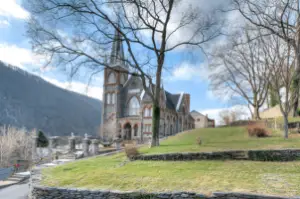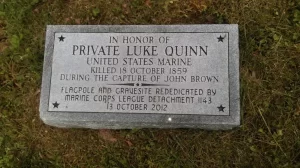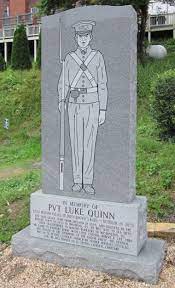Private Luke Quinn United States Marine Corps
It was October 16, 1859 when Connecticut native John Brown, saying his purpose on earth was to free all slaves in the South, led his own sons, a group of five other men and a small handful of slaves to the federal arsenal in Harpers Ferry, at the time, a part of Virginia, but since the 1860s, West Virginia.
His purpose was to take over the arsenal, capture all the weapons and ammunition and proceed to lead slaves in a revolt against the families who owned them. Two of Brown’s own sons were killed as well as a freed slave in his insurrection.
But also killed in defense of the federal arsenal was a US Marine, a 20 year old Irish kid named Luke Quinn.
Quinn was a private in the Corps, having enlisted in the Marines in Brooklyn, going on to the Marine Barracks in Washington, DC, then serving on the frigate USS St. Lawrence and the USS Perry, taking him on expeditions to Brazil and Paraguay. Back in the United States, he was dispatched with a Marine company led by then Lt. Colonel Robert E. Lee, with Lt. J.E.B.Stuart in charge of his unit.
Brown and his army had barricaded themselves in the engine room building in Harpers Ferry on the army site. When he refused to surrender to Lee, the Army General ordered the attack. Quinn was one of the first 100 Marines to enter after barricading the doors with hammers ladders and other tools.
He was shot, wounded, and lying in pain, knowing he was near death. He called out for a priest. He had five weeks until the end of his enlistment.
The Rev. Michael Costello was pastor of St. Peter’s Church at that time, the same Church which later would serve as a hospital for so many wounded from both sides during the Civil War. Still in active use, it is also the only church that survived the Harper’s Ferry insurrection and subsequent Civil War.

Fr. Costello wrote a letter months after the event to tell the story of Pvt. Quinn when he was called to give him Last Rites. There were two Marines wounded, he wrote, and both were catholic. He attended to them both and said Quinn died that day and was buried with full military honors in St. Peter’s Cemetery.
In testimony during the court hearing before Brown was hung for murder and treason, it was said that Brown himself had shot Pvt. Luke Quinn as he fought to preserve the federal arsenal. The Irishman was 24 years old and had been in America 15 years.
Quinn’s grave at the cemetery remained unmarked for another 68 years until a couple of local residents took efforts to locate the grave and provide a proper marker. They found remains that assured them it was the Marine’s remains and a Holy Name Society erected a monument on the site.
In 2012, a Marine Corps League detachment rededicated the gravesite and erected a flag pole and a new marker.
Yet, with all the history, and with a near life size statue of Pvt. Quinn in the Lower section of Harpers Ferry near the steps leading to the town’s upper section, it was difficult to find someone who knew where the cemetery was, let alone Pvt. Quinn’s grave.
It was raining two weeks ago when I went into the Harpers Ferry Police Headquarters after not being able to find anyone who could tell me where the cemetery was. That’s where I met Varlissa a tireless employee at the police department who manned the front office by herself and was busy in her Washington Street Borough Hall and Police Department office.
Not too busy to take the time to help a visitor, however. Varlissa, who had also been a National Parks employee for ten years before working for the town, gave me reams of history about the town, Jefferson Rock, John Brown and so many other fascinating facts about the town before explaining where the cemetery was. Not satisfied with merely giving me directions, and knowing I was on foot, Larissa printed them out to make it easy to follow turn by turn. It was a little more than a mile distant on the side of the highway and actually in Bolivar.
The walk was up and down the hills that are so much a part of Harpers Ferry and neighboring Bolivar, and the cemetery was just the other side of the Quality Inn on the highway. The greying stones and the broken markers, in spite of the well kept and manicured lawns of the cemetery, were proof the earliest graves at the still active graveyard were near the top of the property. A tall flag post with the American flag flying was the first indication that that was where Pvt. Quinn’s grave was located.
After reading the inscriptions and paying respects at the grave, I returned to town to see both Varlissa and Sgt, Mike of the local police department waiting to assure I found my way and arrived back in town. The police officer also filled me in on more history of the town both employees love, respect, and work for, thanked me for my interest in its history and stayed to answer my many questions on more history of Harper’s Ferry.
They were happy I was a tourists to their town, and I couldn’t be happier that I met a couple of employees who knew so much of its history.
Want to read more stories f my solo travels … usually by train? Click HERE

